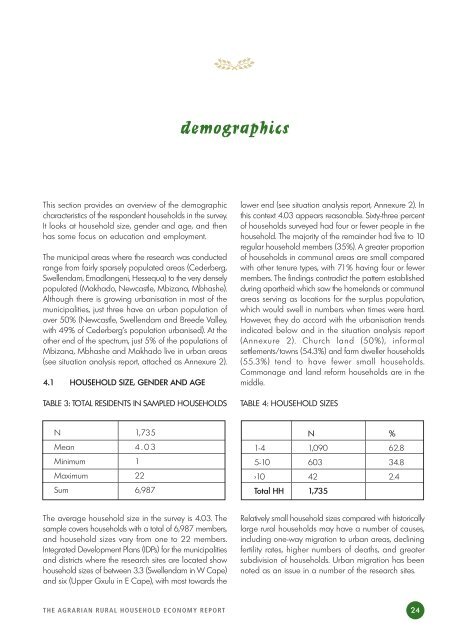THE AGRARIAN RURAL HOUSEHOLD ECONOMY
THE AGRARIAN RURAL HOUSEHOLD ECONOMY
THE AGRARIAN RURAL HOUSEHOLD ECONOMY
Create successful ePaper yourself
Turn your PDF publications into a flip-book with our unique Google optimized e-Paper software.
This section provides an overview of the demographic<br />
characteristics of the respondent households in the survey.<br />
It looks at household size, gender and age, and then<br />
has some focus on education and employment. .<br />
The municipal areas where the research was conducted<br />
range from fairly sparsely populated areas (Cederberg,<br />
Swellendam, Emadlangeni, Hessequa) to the very densely<br />
populated (Makhado, Newcastle, Mbizana, Mbhashe).<br />
Although there is growing urbanisation in most of the<br />
municipalities, just three have an urban population of<br />
over 50% (Newcastle, Swellendam and Breede Valley,<br />
with 49% of Cederberg’s population urbanised). At the<br />
other end of the spectrum, just 5% of the populations of<br />
Mbizana, Mbhashe and Makhado live in urban areas<br />
(see situation analysis report, attached as Annexure 2).<br />
4.1 <strong>HOUSEHOLD</strong> SIZE, GENDER AND AGE<br />
TABLE 3: TOTAL RESIDENTS IN SAMPLED <strong>HOUSEHOLD</strong>S<br />
N 1,735<br />
Mean 4.03<br />
Minimum 1<br />
Maximum 22<br />
Sum 6,987<br />
The average household size in the survey is 4.03. The<br />
sample covers households with a total of 6,987 members,<br />
and household sizes vary from one to 22 members.<br />
Integrated Development Plans (IDPs) for the municipalities<br />
and districts where the research sites are located show<br />
household sizes of between 3.3 (Swellendam in W Cape)<br />
and six (Upper Gxulu in E Cape), with most towards the<br />
<strong>THE</strong> <strong>AGRARIAN</strong> <strong>RURAL</strong> <strong>HOUSEHOLD</strong> <strong>ECONOMY</strong> REPORT<br />
demographics<br />
lower end (see situation analysis report, Annexure 2). In<br />
this context 4.03 appears reasonable. Sixty-three percent<br />
of households surveyed had four or fewer people in the<br />
household. The majority of the remainder had five to 10<br />
regular household members (35%). A greater proportion<br />
of households in communal areas are small compared<br />
with other tenure types, with 71% having four or fewer<br />
members. The findings contradict the pattern established<br />
during apartheid which saw the homelands or communal<br />
areas serving as locations for the surplus population,<br />
which would swell in numbers when times were hard.<br />
However, they do accord with the urbanisation trends<br />
indicated below and in the situation analysis report<br />
(Annexure 2). Church land (50%), informal<br />
settlements/towns (54.3%) and farm dweller households<br />
(55.3%) tend to have fewer small households.<br />
Commonage and land reform households are in the<br />
middle.<br />
TABLE 4: <strong>HOUSEHOLD</strong> SIZES<br />
N %<br />
1-4 1,090 62.8<br />
5-10 603 34.8<br />
>10 42 2.4<br />
Total HH 1,735<br />
Relatively small household sizes compared with historically<br />
large rural households may have a number of causes,<br />
including one-way migration to urban areas, declining<br />
fertility rates, higher numbers of deaths, and greater<br />
subdivision of households. Urban migration has been<br />
noted as an issue in a number of the research sites. .<br />
24


